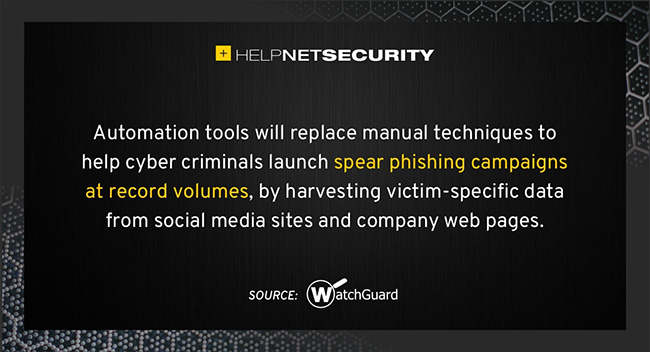Automation to shape cybersecurity activities in 2021
Automation will play a major role in shaping cybersecurity attack and defence activities in 2021, WatchGuard predicts.

Traditionally a high-investment, high-return targeted attack, in 2021 automation tools will replace manual techniques to help cybercriminals launch spear phishing campaigns at record volumes, by harvesting victim-specific data from social media sites and company web pages.
Automated spear phishing attacks to prey on fears
And as society continues to grapple with the impact of COVID-19, it is likely that these automated spear phishing attacks will prey on fears around the pandemic, politics and the economy.
Conversely, the research team believes that automation will also help cloud-hosting providers such as Amazon, Microsoft and Google to crack down on cybercriminal groups abusing their reputation and services to launch malicious attacks.
Threat actors commonly host website HTML files designed to mimic a legitimate website like Microsoft 365 or Google Drive to steal credentials submitted by unsuspecting victims. But in 2021, these companies will deploy automated tools and file validation technologies that will spot spoofed authentication portals.
In its annual look ahead to the next 12 months, the tumultuous events of 2020 will impact the threat landscape next year and for years to come. Other predictions include:
Attackers swarm VPNs and RDPs as the remote workforce grows
As more companies adopt VPNs and Remote Desktop Protocol (RDP) solutions to provide secure connections to employees working from home, attacks against them will double in 2021. If an attacker can compromise VPN, RDP or remote connection servers, they have an unobstructed path into the corporate network.
Security gaps in legacy endpoints targeted
Endpoints have become a high priority target for attackers during the global pandemic and many personal computers are still running legacy software that is difficult to patch or update.
With Microsoft just ending its extended support program for Windows 7, organizations are warned to expect at least one major new Windows 7 vulnerability to make headlines in 2021.
Services without MFA will suffer a breach
Authentication is the cornerstone of strong security; but with billions of usernames and passwords available on the dark web and the prevalence of automated authentication attacks, no Internet-exposed service is safe from cyber intrusion if it isn’t using multi-factor authentication (MFA). In fact, any service without MFA enabled is highly likely to be compromised in 2021.
“As we have learnt in 2020, it is very difficult to predict what is going to happen in the future,” says Corey Nachreiner, CTO at WatchGuard.
“But our Threat Lab team along with other researchers around the world have an increasing level of analytics and insight to make well-informed guesses. Cybercriminals always look for the weak links, so the growing ranks of home workers are an obvious target and when it comes to new technologies such as automation and AI, what can work for good, can also be exploited for malicious activity. It’s just a case of trying to stay one step ahead.”